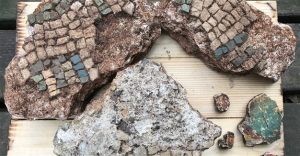Archaeologists excavating a monastery complex on the Giresun Island on the Black Sea, known for being a significant religious centre in the Byzantine era, revealed facts of daily life and traditions of the site.

Archaeologists have unearthed remains of a church, tower and monastery, six tombs with graves in Byzantine burial traditions, and remains of other structures throughout the island. According to the researchers, among the most important findings of this year are the pieces of frescoes in yellow, red and green colours, which are supposed to be pieces of the church. However, the mosaics of the palace under the church are torn to pieces and the site is reported to have suffered considerable damage due to illegal excavations. Many artefacts found at the site are reported to date to 13th century AD, including a green-glazed bowl from the historical Zeuksippos family group. The tombs found within the complex were covered with roof tiles were raised in Byzantine burial traditions. They contained skeletons of men who died in their 30s A coin was put on the toe in some tombs and several scallops were left within one of them. The researchers established that the island was surrounded with walls in the past, but almost all of the walls collapsed throughout history and the ruins of the church, tower, monastery, chapel, cistern and lots of large storage containers (pithoi), have remained.
(after Hurriyet Daily News)